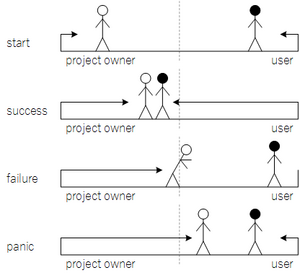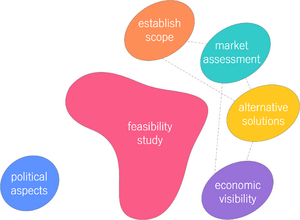Feasibility Study
A Feasibility Study (FS) serves as a holistic decision basis for determining the practicality of a project idea. “There is nothing more unproductive than to build something efficiently that should not have been built at all.” Tim Bryce, Managing Director of M. Bryce & Associates. Worthwhileness is the essential focus of a FS, meaning it aims to determine whether a project is possible and/or reasonable. The distributions of recourses during the lifetime of a project are naturally negatively skewed, consequently it is most beneficial to address adjustments, optimizations, risks, limitations etc. related to a project at the very start. Hence a FS is an optional first stage of a project, where all major aspects of pursuing a given project are studied on a high level.
Conducting a FS enables an objective analysis of a project idea on several measurable aspects. The exact steps of a FS may vary depending a given project type. Typically it will include scope specifications defining the objectives of the project, analysation of the current market stating availible solutions and the potential value of completing the project, an investigation of alternative solutions which satisfy the project objectives and a financial study covering among others the total cost and benefit estimation.
Since a FS requires a considirable investment at an early stage of a project it will mainly be sensible for large projects, where early changes potentially lead to profit in the long run. Moreover the project need to be of a certain open characteristic and/or hold unknown factors in order to potentially benefit from a FS.
Contents |
Conducting a Feasibility Study
There are several sub-studies included in a FS, here five of the most versatile are addressed, i.e. scoping, current market analysis, addressing alternatives solutions, financial study and clarification of political agendas. Bear in mind that a FS is time dependent and thus will only be applicable for a certain project at a specific time. Completing a FS shapes the potential initiation of a project, therefor it is of great importance that it provides a well-informed basis for deciding the direction of this first step in to the realisation of the project. The reliability and strength of a FS depends on the quality of each sub-study as well as of the dynamic managing of the interdependencies between the studies, such as revision of the scope due to a discovery encountered during market studying. Visually presented on the figure to the right, so to say that the stability of the step depends on how well the centre of the paw is supported by the toes. To illustrate the essence of each of the five steps an example of a rail- and highway water crossing is used in the following.
Scope
To ensure the quality of a FS specifications of objectives need to be established. This includes the background and the purpose of the project, requirements which need to be met once the project is finalised, the budget and the time frame. Scoping at this stage may be of open as well as well defined characteristics depending on the requirements needed to be satisfied. All other steps of the FS will be based on the scope, therefore an inadequate scope will lead to misleading results and a too narrow scope may result in sufficient alternative solutions being overlooked. In some cases it may be recommended to carry out initial studies in order to roughly estimate if the objectives of the scope are sensible. This mainly concerns projects where data from similar cases are not available or simply do not exist.
In our rail- and highway water crossing example a scope should specify who will benefit from it, what the problem is with the current solution, it could be a ferry line or a crossing at a different geological location. The location should also be stated as this will be governing for the length and the foundation of the structure. Clearly the contents of the project need to be addressed, which are the number of lanes, speed limits, safety requirements etc. Lastly a rough estimation of effects should be included, such as the reduction of travelling time, how many travellers and the like.
Market assessment

Analysing the current solutions to the problem may cover investigating copyrights, regulations and faults in current system if there already is one. This step will uncover whether the concerned project is in fact a suitable solution and if there is a sufficient demand. If so this investigation will contribute with an overview of the users' needs and thereby the scope of the project may change accordingly. On the other hand the conclusion may be that repairing the existing solution will be a more viable choice than pursuing the project. If the latter is the case one must be careful to keep focus on the task and make sure not use unnecessary time on optimizing on the existing solution.
Regarding the water crossing project a study of the current market should include an investigation of the type and numbers of user who potentially will prefer the new solution over the existing. Additionally, it should present a technical prognosis of how the new water crossing will affect the traffic in the future, which will form the basis of the financial study and determine the needed capacity. Moreover, the existing solutions must be examined and their shortcomings specified. Once this part of the study is performed it will provide a clear picture of the magnitude of the demand, thus how much support the project is expected to receive or conclude that expanding the existing road or setting in an extra ferry is a more practical solution.
Alternative solutions
Based on the specifications manifested in the scope, which may have been revised once the market analysis is completed, alternative solutions are proposed and considered. Initially this step requires a brainstorm exercise of create a palette of sufficient solutions to the problem in concern. Hereafter the practicality of each solution is investigated, i.e. determining if a given solution is possible to implement within the budget and time frame set for the project.
Economic visibility
Potential investors.
Cost estimate.
Pay back time.
Cost benefit analysis.
Political aspects
State level. Agenda.
Organizational level. Policies, strategy.
Limitations
Time consuming. Requires an investment at an early stage. Need of flexibility to implement discoveries made in the FS. Uncertainties of the studies.
[2].
References
- ↑ Dingle, J. (1985). Project feasibility and manageability. International Journal of Project Management, 3(3), 94-103.
- ↑ Hofstrand, D. and Holz-Clause, M. (2009). What is a Feasibility Study? Retrieved from https://www.extension.iastate.edu/agdm/wholefarm/pdf/c5-65.pdf
Annotated Bibliography
Keep in mind
Structure
- Big idea: describe the tool, concept or theory and explain its purpose. The section should reflect the current state of the art on the topic
- Application: provide guidance on how to use the tool, concept or theory and when it is applicable
- Limitations: critically reflect on the tool/concept/theory. When possible, substantiate your claims with literature
- Annotated bibliography: Provide key references (3-10), where a reader can find additional information on the subject. Summarize and outline the relevance of each reference to the topic. (around 100 words per reference). The bibliography is not counted in the suggested 3000 word target length of the article.
Evaluation
- Quality of the summary: Does the summary make the key focus, insights and/or contribution of the article clear?
- Structure and logic of the article: Is the argument clear? Is there a logical flow to the article? Does one part build upon the other? Is the article consistent in its argument and free of contradictions?
- Grammar and style: Is the writing free of grammatical and spelling errors? Is the language precise without unnecessary fill words?
- Figures and tables: Are figures and tables clear? Do they summarize the key points of the article in a meaningful way?
- Interest and relevance: Is the article of high practical and / or academic relevance? Is it made clear in the article why / how it is relevant?
- Depth of treatment: Is the article interesting for a practitioner or academic to read? Does it make a significant contribution beyond a cursory web search?
- Annotated bibliography: Does the article properly cite and acknowledge previous work? Does it briefly summarize the key references at the end of the article? Is it based on empirical data instead of opinion?
